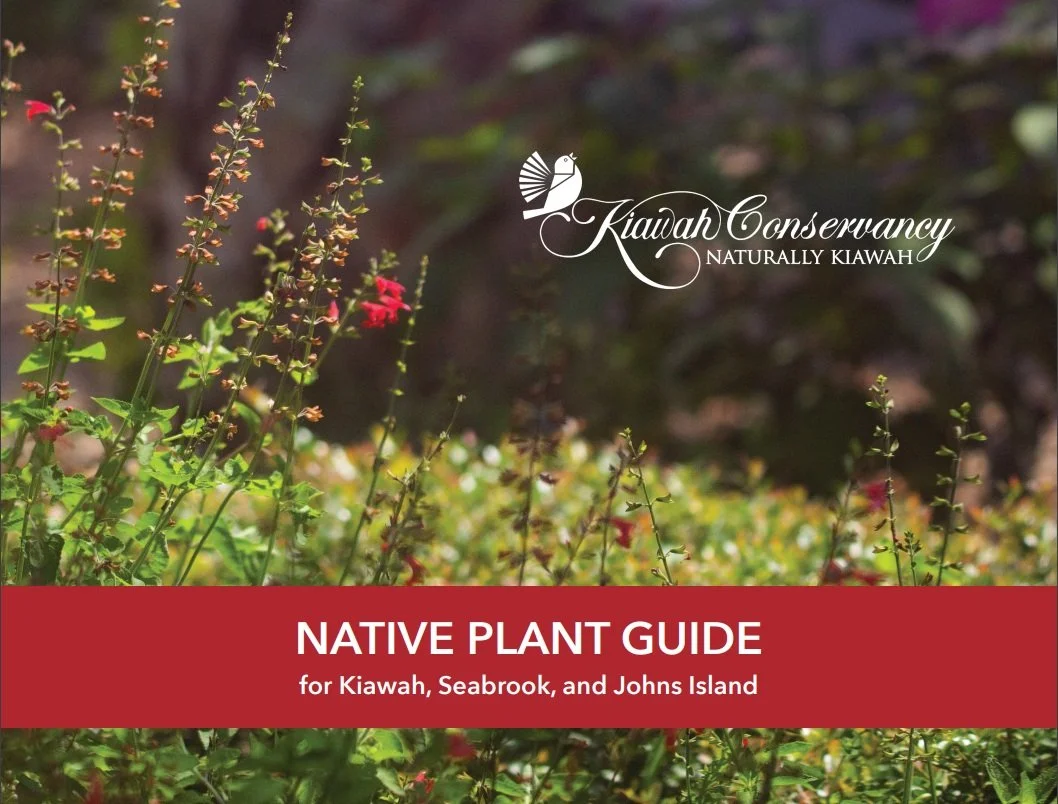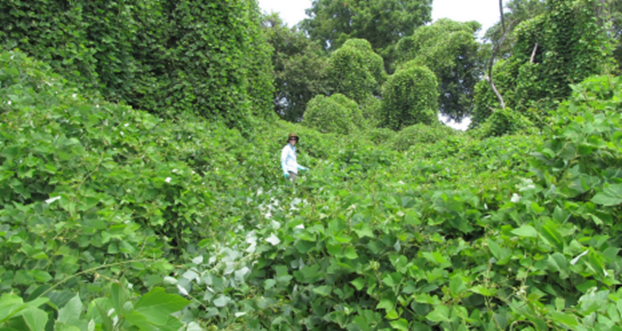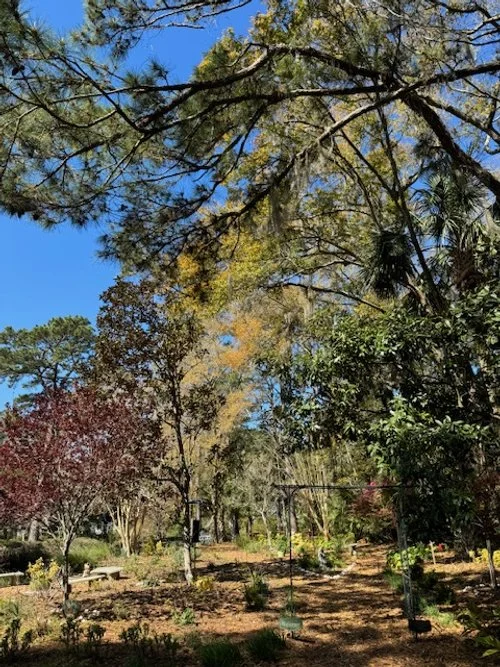Celebrate South Carolina Native Plant Week with us! The Kiawah Conservancy and the Seabrook Island Green Space Conservancy are excited to offer a selection of native plants perfect for the coastal conditions of Kiawah, Seabrook, and Johns Island. These plants support local wildlife and have thrived in gardens within the Kiawah River Watershed. By pre-ordering one or more of the plant groupings, which are shown below, you can save money and enhance your landscape with beautiful native plants.
Planting native species provides medicine for our Earth. These plants support local wildlife, are adapted to local conditions, and promote biodiversity. We hope this sale inspires you to create a beautiful, native plant-filled landscape. Planting native plants is not just about changing the look of your garden, it's about creating a vibrant, thriving ecosystem.
Pre-order Deadline: October 1
Pick-up Date: October 15 (10 am - 4 pm at Night Heron Park, Kiawah Island)
*If you're not available to pick up on this date, please make arrangements with a neighbor or friend or wait for our next plant sale.
Since the plants are pre-purchased, no refunds can be given. In the event of limited availability of a certain plant, a similar one will be substituted. This sale is sponsored by the Kiawah Conservancy and the Seabrook Island Green Space Conservancy. The plants are offered at cost directly from the nursery; the conservancies do not benefit financially.
PLANT GROUPINGS
Plant groups are based on sunlight and soil moisture needs. This ensures that plants thrive together. One grouping (up to 4 trays) will easily fit in a sedan. Two groupings (up to 8 trays) will easily fit in a large SUV or truck.
For all of the details about the plant groupings, including photographs of the plants, please go to https://kiawahconservancy.salsalabs.org/NativePlantPackagesFall2024/index.html
A New Native Plant Guide for Kiawah, Seabrook,
and Johns Island
Click the photo to access the guide
NEW PRESENTATION!!!
Interested in learning more?
Click on the recording below to view the presentation given by Christopher Burtt, Urban Horticulture Agent and Master Gardener Coordinator for Clemson Cooperative Extension.
All about Native and Invasive plants on Seabrook Island
Invasive Plant Species on Seabrook Island
by Barry Shedrow
Invasive plant species are defined as plants that are non-native and harmful to an established ecosystem. The introduction of non-native plants into a new environment can result in significant ecological, economic, and/or human health issues. While the spread of invasive plantspecies can occur naturally (mediated by wind, water or wildlife), their spread is primarily attributable to human-related activity. For millennia, humans have introduced non-native plants into new geographic areas. Although most human-facilitated plant invasions are unintentional, there are instances when the introduction of non-native plants was intentional. English ivy (Hedera helix) and kudzu (Puervaria montana) are two well-known examples. The introduction of these non-native plant species has proven to be disastrous for the natural environment. Both English ivy and kudzu grow and spread rapidly, their runners climb over and smother anything in their path, including trees, shrubs and buildings. Kudzu has earned the moniker “the vine that ate the South”. Wherever these plants have become established, native vegetation has been crowded out and wildlife habitat degraded. Over the years, significant resources have been expended to control or eradicate these two invasive plant species.
Impacts of invasive plant species on established, healthy ecosystems include diminishment of plant and animal species diversity; degradation of wildlife habitat; increased soil erosion; degraded water quality; and decreased recreational opportunities.
Invasive plants possess attributes that allow them to outcompete native plant species in an established ecosystem. These characteristics include rapid growth and reproduction, high
dispersal ability, and tolerance to a wide range of environmental conditions. A non-native plant can become invasive if it outcompetes native plant species for critical resources such as nutrients, light, physical space, and/or water. For example, non-native plants may be able to utilize natural resources that are not available to native plants (e.g., previously uninhabited soil types or a deep water source). Some invasive plant species can also alter their environment in ways that inhibit
native plants (e.g., releasing toxic chemicals, shading out other plants, affecting the behaviour of herbivores). The invaded ecosystem may have few or no natural competitors to the non-native plant, thus allowing the invader to spread and reproduce rapidly. Alternatively, there are scenarios where an invasive plant species may co-exist with native plant species for an extended period of time as it adapts to its new environment. Only gradually does its competitive edge becomes apparent as its population grows larger and denser.
Changes in landscape can also present an opportunity for the establishment of an invasive plant species. For example, when a cleared lot is adjacent to an undisturbed forested area, an ‘edge habitat’ is formed where the two distinct ecosystems share a common boundary. The creation of edge habitat is common on Seabrook Island due to the frequent clearing of undisturbed landscape to accommodate residential development. Light, moisture and other environmental conditions within an edge habitat are unique and can present an opportunity for the establishment of non-native plant species that would otherwise not thrive in either a forested area or a residential lot.
Invasive plant species are successful because they
• Outcompete native plant species for moisture, sunlight, nutrients, and space • Produce large quantities of seed
• Thrive on disturbed soil or previously uninhabited soil types
• Disperse their seed over great distances via wildlife, wind, and/or humans • Possess aggressive root systems that
spread long distances from a single plant and often grow so dense that they smother the root systems of native vegetation
• Produce chemicals in their leaves or root systems that can inhibit the growth of other vegetation.
There are two methods of controlling invasive plants: mechanical and chemical. Mechanical control methods include pulling out or
digging up the plants; suffocating the plants with plastic sheeting; and frequent cutting or mowing of the plants. Chemical control
of invasive plants involves the use of herbicides. The two most commonly used herbicides are glyphosate (RoundupTM) or
triclopyr (Brush-B-GoneTM and GarlonTM). These herbicides are applied by either spraying on the plant’s leaves (‘foliar’ method) or pouring directly into a stem cut (‘cut stem’ method). The preferred disposal method for invasive plant material is by burning. Any residual plant material left onsite could result in the area being reinfested.
Invasive plant species are a problem throughout the United States, and Seabrook Island is no exception. Non-native plant species can be found on SIPOA’s green space properties as well as on residential properties. Invasive plants were introduced to the island primarily by human-
related activities (horticulture, tourism, construction) and, to a lesser extent, wildlife. The invasive plant species of greatest concern on Seabrook Island are the following: • Oleaster (Elaeagnus sp., native to Japan, Korea and China)
• Chinese tallow (Triadica sebifera, native to eastern China and Taiwan) • Pampas grass (Cortaderia selloana, native to southern South America) • Privet (Ligustrum sp., native to Europe, north Africa and Asia)
• Beach vitex (Vitex rotundifolia, native to China, Japan and Oceania)
A comprehensive survey of invasive plant species on Seabrook Island has never been conducted. However, a listing of invasive plant species on Kiawah Island has been published and it is reasonable to assume that this information is representative of Seabrook Island. This publication can be viewed online at https://s3-us-west-2.amazonaws.com/kiawah-island/wp content/uploads/2016/11/28184857/Vegetation_Survey_of_Kiawah_Island.pdf.
SIPOA’s Environmental Committee is working jointly with the Seabrook Island Green Space Conservancy to implement an environmental monitoring program to locate and irradicate invasive plant species within SIPOA’s green space conservation properties. The objective of this monitoring program is to improve wildlife habitat by removing non-native plants. The Seabrook Island Green Space Conservancy is also working to develop a community outreach program to educate residentsregarding invasive plants and the importance of not using them for ornamental or landscaping purposes. If you have questions regarding either of these planning efforts, contact Barry Shedrow (barry@shedrow.com).
Selected Resources
1. Adrea Hughes, SIPOA staff arborist (ahughes@sipoa.org)
2. Clemson University Regulatory Services (https://www.clemson.edu/public/regulatory/plant industry/invasive/index.html)
3. US Department of Agriculture Animal and Plant Health Inspection Service (https://www.aphis.usda.gov/aphis/ourfocus/wildlifedamage/operational activities/sa_invasive/ct_invasive_species1)
4. Gramling, J.M., 2012. “A Vegetation Survey of Kiawah Island, Appendix III”.
PDF download of document
Kudzu: The vine that ate the South
This is the first article in a series about native plants in Seabrook, Kiawah, and Johns Island.
This is something I can do to help wildlife By Stan Macdonald
(This is the first article in a series about native plants in Seabrook, Kiawah, and Johns Island.)
Lee Hurd is small in stature but a giant in determination, and after reading a book last year by entomologist Douglas Tallamy urging homeowners to transform their yards into more wildlife friendly habitats, she acted quickly.
First, at her tree-shaded Seabrook Island home along a lagoon, a yard crew removed what she now realizes was an infestation of invasive plants. A tractor hauled away plants like the dense, bushy Elaeagnus shrub, a fast-spreading plant introduced in this country from Asia. Elaeagnus, sprouting up to 25-feet high, shades out native vegetation. Lee was creating space for native plants because in general they provide more benefits to caterpillars and other insects, which are essential to all life as pollinators and a main source of food for birds and other animals, according to Tallamy and other scientists.
(Unfortunately, Elaeagnus, including a variety called Thorny Olive, is quite common in this region. The Seabrook Island Property Association (SIPOA) recently removed 280 of the shrubs from its properties, including undeveloped home lots acquired by the island’s Green Space Conservancy, but many of the plants remain in private yards.)
After removing invasives, Lee “jumped right in” planting natives in spring 2022, although in retrospect, she said, she should have been more deliberate. Her initial efforts produced “varied” results -- the deer ate some of the new plants, forcing her to narrow the selection. “It’s a learning process. I wasted a lot of money on things that didn't do well here. But you know, you have to try it to learn.”
Lee and her husband Doug have lived at Seabrook for 33 years, and twice a year they host at their property the Seabrook Lakes Yacht Club Regatta party. Friends and neighbors who attend have donated plants, money and help in the garden, which Lee appreciates. “At 88,” she said, “I can only do so much.” When the “regatta” is held this fall, participants will see a changed landscape – yes, there will still be traditional garden plants, but now mixed in are thriving natives, including mountain mint, flowering plants in the Pycnanthemum genus that attract insects; Beautyberry (Callicarpa americana), offering berries favored by some birds; Georgia savory (Clinopodium georgianum), a small shrub with bright flowers (“a perfect shade plant,” Lee says), and Blue-eyed grass (Sisyrinchium angustifolium), delicate plants with small blue flowers that border the Hurd’s garden pathways.
Lee welcomes visitors to her garden at 2116 Loblolly Lane and she hopes more homeowners will “think outside the box,” realizing that native plants can be good substitutes for nonnatives. Scientists say insects and birds are facing global declines because of climate change, habitat loss, and other forces, and that motivates Lee. “I can't do much, but this is something I can do or at least try, you know.”
This is the second article in a series about native plants in Seabrook, Kiawah, and Johns Island.
OUR FIRST EXPERIENCE WITH NATIVE PLANTS By Stan Macdonald
In early November, while it was still warm enough to plant on Seabrook Island, my wife Sally and I asked Sean Cannon to see whether our traditional, tidy-looking yard on Old Drake Drive offered much nourishment to wildlife.
After a brief walk around, Sean, a staff member of the Kiawah Conservancy, said that we had a solid tree canopy, including oaks and palmettos, but our ground cover was another story. It was filled mostly with pine straw and lacked native plants that support insects like ants, bees, and caterpillars – the tiny creatures that are life-giving pollinators of plants and serve as a critical food source for birds and other wildlife.
“You might have areas for birds to build a nest,” Sean told us, “but you don’t have plants to create a nursery for insects.” He also suggested adding thicker vegetation, perhaps bordering our neighbor’s yard, where an ascending array of native ground plants, shrubs and trees would form a barrier and offer food and shelter for animals. These wildlife safe havens are often removed during the construction of new homes.
Sean is a leader of a joint native plant initiative by the Kiawah Conservancy and the Seabrook Island Green Space Conservancy to encourage and work with residents – and organizations that oversee public spaces – in finding ways for nature to thrive on our islands, despite increasing habitat loss due to human development – and despite other stressors like climate change, pesticides, and air and light pollution. As the public becomes more aware of the toll on wildlife, including the alarming declines of insects and birds in the U.S. and worldwide, more people want to engage.
One starting point is in the yard. In our case, we purchased a “shade garden” package at the native plant sale at Freshfields Village last November. It was the first joint sale sponsored by the Seabrook and Kiawah conservancies, and more than 90 shade and sun packages were sold at wholesale cost. The enthusiastic response persuaded the conservancies to hold a second sale this spring. It is set for May 18 at Kiawah Island’s Night Heron Park.
The native plants in the packages offer distinct advantages. They are adapted to our local climate and sandy soils; they don’t require pesticides and once established, they need little watering. Also, many native insects are highly attached to native plants because they coevolved together over thousands of years. In sum, native plants provide more benefits to insects, on average, than nonnative ornamental species, scientists say.
Our shade package totaled 45 plants, a mix of wild bergamot, woodland phlox, southern shield fern, Stokes’ aster, and white wood aster. Asters, those gorgeous late season bloomers, are particularly potent insect generators; they nurture caterpillars, which songbirds rely on for food, and they attract migrating butterflies. (The sun package also had butterfly-friendly plants, including milkweed which hosts monarchs but also attracts many other beneficial insects.)
In truth, Sally and I didn’t do the heavy lifting, thanks to Sean, who got us “into the ground.” The process was straightforward – prepare a bed in a shaded area, install the plants following an illustrated design provided at the plant sale and then cover the bed with shredded bark, which is expensive, but holds moisture better than pine straw and adds nutrients as it decomposes. And then on Sean’s advice, we watered daily for the first week and sprayed on heavy doses of deer repellent, which we purchased at Lowe’s. (The plants in the packages are deer resistant and as of early March, we’ve encountered no deer problems.)
Our hope is to add more plants in an attractive pattern, using a mix of natives and ornamentals. True, it’s just our small yard, but if more and more residents – and governing organizations -- on the islands take a communal approach and remove invasive species and plant more natives, this collective action will expand the natural habitat, offer more protection for wildlife, and give us a shared sense of being good stewards of the land.
As the spring takes hold, Sally and I are eager to see what our garden has in store, perhaps something as stunning as the delicate blue flowers of Stokes’ asters that were blooming in December and January.
Lee Hurd’s garden
Sean Cannon





